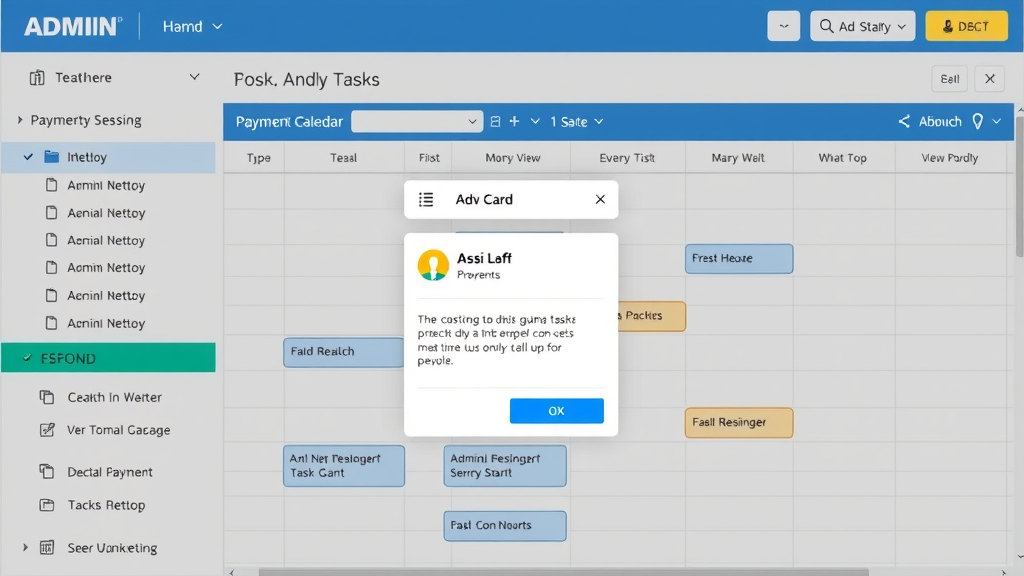Did you know that property services businesses spend up to 30% of their time on manual administrative tasks? Just imagine what your business could achieve if you could save time and reduce admin work across your back office. From data entry and invoice processing to expense tracking and payment reminders, automated admin is transforming the way small businesses handle their administration tasks. In this guide, you’ll learn how AI and smart automation tools can help you cut costs, boost accuracy, and unlock growth by eliminating repetitive admin work—so your team can focus on what really matters: your clients and your business needs.

Unveiling the Power of Automated Admin: Why Property Services Businesses Should Embrace It
"Did you know that property services businesses spend up to 30% of their time on manual administrative tasks?"
For property services businesses, administrative tasks can quickly pile up. Manually handling data entry, correspondence, and financial paperwork takes away time that you could spend serving clients or growing your brand. Automated admin tools powered by AI are designed to tackle these challenges head-on. By tapping into automation, local property service business owners can significantly reduce admin workload, minimize human error, and ensure that essential processes, like expense tracking and payment reminders, never fall through the cracks.
The real benefit is more than just saving time. Modern automation platforms are intuitive, user-friendly, and tailored to small business needs. They streamline back office operations, ensuring that admin tasks are done quickly and accurately. By migrating routine tasks from manual to digital with AI-driven solutions, your staff is free to focus on revenue-generating activities. This shift—powered by tools like CRM systems and automated invoicing—leads to greater efficiency, compliance, and long-term business sustainability for property services firms.

What You'll Learn About Automated Admin in This Guide
- How automated admin reduces administrative tasks
- Effective ways to save time and money with automation
- Step-by-step insights on implementing AI for administration tasks
- Expert strategies for automating invoicing, expense tracking, and reminders
Understanding Automated Admin for Back Office Efficiency
Defining Automated Admin and Its Role in Administrative Tasks

Automated admin refers to the technology-driven process of managing administrative tasks using AI, bots, and integrated digital tools. Instead of relying on hours of manual data entry and paperwork, businesses leverage automation software to handle repetitive admin work efficiently and accurately. In the context of property services, this could mean autogenerated invoices, real-time expense logging, or automatic payment reminders to clients.
What sets automated admin apart is its ability to handle high volumes of administrative tasks with minimal human intervention. It reduces manual workloads, eliminates repeated errors, and standardizes document flows across small business teams. AI-driven admin support offers a smarter way to keep your back office running smoothly, integrating with CRM systems, business management tools, and communication platforms for seamless administration. As a result, your team is freed from daily drudgery, and your processes run like clockwork—without manual oversight.
The Impact of Automated Admin on Small Business Workflows
"Automated admin transforms time-consuming administration tasks into seamless operations, especially vital for property service businesses managing daily data entry demands."
For small business owners and managers in property services, the impact of automating admin tasks is profound. Routine jobs like entering receipts, emailing invoices, or tracking payments are not only tedious but also prone to error, which can impact your cash flow and customer experience. By implementing automated admin, you can save valuable hours every week, ensuring your attention is on delivering excellent services rather than chasing paperwork.
Further, automation allows your back office to scale as your business grows, without the need for extra hands. Easy integrations with CRM systems help keep client information current and communication timely, while analytics dashboards provide an instant overview of outstanding admin tasks. The bottom line? Automated admin enables your business to act more professionally, respond faster to customers, and take control of its financial health.
How AI-Driven Automated Admin Saves Time and Money
Eliminating Repetitive Tasks: The Shift from Manual to Automated Admin
Repetitive admin work—such as manual data entry, sending reminders, or reconciling payments—can drain into hundreds of hours each year. By adopting automated admin, property services businesses can automate repetitive actions and ensure routine tasks are completed without manual input. This not only saves time for your team but also reduces the risk of human error that can lead to costly mistakes or compliance issues.
Moreover, modern automation tools are built to be adaptable, fitting the specific workflow and business needs of property service companies. Whether you’re a small business just starting out or a growing local firm, automating your administration tasks makes your back office scalable, responsive, and robust. The immediate payoff: more time for strategic growth, improved customer satisfaction, and a better use of business resources.
Key Admin Tasks You Can Automate in Property Services
- Data entry
- Invoice generation
- Expense tracking
- Payment reminders
- Correspondence and client updates
Many businesses start their automation journey by prioritizing high-impact, repetitive admin tasks. Automating data entry and invoice generation not only improves accuracy but also accelerates the billing cycle. Expense tracking can happen in real time, with digital receipts instantly uploaded and filed. Automated payment reminders keep your cash flow healthy, while automated correspondence keeps clients informed—without the need to write and send each message manually. Today’s business management and CRM systems make it easy for property services companies to bring all these aspects of administration tasks into a single, unified platform.

Automated Invoicing: Streamlining Financial Administration Tasks
Overview of Automated Invoicing Solutions for Small Business
Invoicing is one of the most important yet time-consuming administrative tasks for property services businesses. Missing or delayed invoices can disrupt cash flow and strain relationships with clients. Automated admin solutions enable you to generate, send, and track invoices effortlessly—using predefined templates, integrated payment links, and real-time updates. Small business owners benefit from reduced paperwork, faster payments, and fewer invoice errors, while clients appreciate clear, professional communication.
Choosing the right automation tool means looking for features tailored to your business system: compatibility with your existing CRM system, ease of customisation, and built-in checks to prevent human error. Whether you’re sending a handful of invoices each month or managing dozens across multiple properties, automated invoicing scales with your growth and ensures your admin tasks don’t get left behind.
How Automated Admin Transforms Invoice Processing
Using an automated admin platform for invoicing revolutionizes the payment process. With AI-driven tools, invoice creation is as simple as a few clicks—no need for manual data entry or checking for missing information. Automation platforms also come with smart scheduling options, so recurring invoices are sent out automatically, helping you stay on top of regular billing cycles while avoiding late or forgotten payments.
This transformation means your admin staff can focus on following up with clients or resolving disputes, rather than spending hours on repetitive admin work. Plus, every invoice is logged and tracked in your business system, making reconciliation and reporting fast and accurate. With tools like these, many businesses report fewer payment disputes, better tracking of outstanding invoices, and more reliable cash flow management.
Comparison Table: Manual vs Automated Invoicing
| Criteria | Manual Invoicing | Automated Invoicing |
|---|---|---|
| Speed | Slow – can take hours to prepare and send invoices | Fast – generates and sends invoices in minutes |
| Error Rate | Higher – prone to human error and missing details | Lower – automation reduces mistakes with standard templates |
| Cost | Higher – requires significant admin time | Lower – reduces man-hours and associated costs |
| Scalability | Challenging – limited by human input | Easy – handles growth effortlessly |
Case Study: Automated Admin in a Property Services Firm
One London-based property management firm recently replaced its manual invoicing and expense tracking system with an AI-driven automated admin platform. The results were immediate: invoice processing time dropped by 75%, and overdue payments were reduced by nearly half within the first quarter. By automating recurring admin tasks, the business also saw a notable improvement in customer satisfaction, as clients began receiving consistent payment reminders and detailed statements without delays.
What stood out most was the ability to scale. As the company expanded its portfolio, the automated system handled an increased volume of financial admin tasks without any additional hires or overtime, maintaining accuracy and compliance at every step. This approach demonstrates just how powerful automated admin can be for property services businesses ready to embrace the next generation of workflow efficiency.

Expense Tracking Automation: Reducing Admin and Increasing Accuracy
AI Tools for Streamlining Administration Tasks in Expense Management

Handling expenses in a busy property services firm can quickly become overwhelming without the right tools. AI-powered automation platforms track every payment, synchronise purchases with digital receipts, and generate real-time budget reports. This approach not only reduces hours spent on manual data entry, but also ensures all information is accurately categorized for compliance and tax reporting.
Thanks to features like receipt scanning and automatic categorisation, small business owners no longer need to rely on memory or paper trails for expense management. These smart solutions eliminate human error, simplify auditing, and provide at-a-glance insights, so you always know where your business stands financially. Ultimately, automated admin saves you time and money, supporting sustainable growth for property management businesses.
Integrating CRM Systems for Seamless Expense Tracking
- Digital receipt capture
- Automated categorization
- Real-time budget reporting
- AI-driven expense forecasting
For maximum impact, automated admin tools should link directly with your existing CRM systems and business management tools. This integration allows for seamless tracking of expenses, eliminating redundant data entry across multiple platforms. Digital receipt capture ensures no expense is missed, while AI-powered categorisation sorts each transaction automatically.
Real-time budget and expense reporting mean that business decisions can be made quickly and confidently, backed by up-to-date numbers. And with AI-driven forecasting, you can anticipate trends, plan for seasonal changes, and avoid common cash flow pitfalls—key benefits for any growing property services organisation aiming to boost accuracy and reduce admin.
Automated Payment Reminders: Never Miss a Due Date Again
How Automated Admin Enhances Client Payment Compliance

Late payments not only disrupt cash flow but can also strain client relationships. Automated admin solutions for payment reminders address this challenge by sending timely heads-ups to clients—without any manual intervention. AI-powered systems schedule reminders based on due dates, invoice terms, and payment history, ensuring no important deadline is overlooked.
Automated payment reminders are often integrated with both your CRM system and invoice automation platform. This allows your back office to work as a single, unified unit, supporting payment compliance and boosting customer satisfaction. Clients appreciate the professionalism, while businesses experience improved payment reliability—an essential ingredient for growth in the property services sector.
Practical Steps to Set Up Payment Reminders with AI
Setting up automated payment reminders is easier than you might think. First, select a management tool or business system with automated admin capabilities. Link your client contact information, invoice schedule, and payment terms. Next, customise the timing and messaging—whether it’s a gentle reminder a week before the due date or a firm notice on the day itself. AI-driven reminders can adapt based on previous payment behavior, ensuring each client receives communication that fits their habits.
Once activated, automation platforms can handle reminders across email, SMS, or even integrated social media channels. All responses are logged, providing you with a clear record of outreach, which is especially useful if further action is required. This streamlined approach frees your team from chasing payments, letting them focus on core business needs and customer experience.
Centralising Admin Tasks: Unifying Your Automated Admin Tools
Syncing Data Entry, CRM Systems, and Social Media for Property Service Workflows
Modern property services businesses are juggling admin tasks across various platforms—data entry in spreadsheets, client notes in a CRM system, correspondence via email, and updates on social media. Automated admin tools can be configured to sync all these tasks, eliminating the risk of information being siloed or missed. By uniting data entry, customer relationship management, and client communications into a single system, businesses can respond faster, track performance more accurately, and keep everyone on the same page.
This centralization also comes with built-in analytics, helping you spot areas where time and money are being lost to repetitive admin work. Dynamic integrations with popular social media platforms allow for real-time client notifications, status updates, or even marketing campaigns—ensuring your brand stays relevant and timely. In short, unified automated admin lets your back office support all business needs efficiently.
Using Powershell Scripts for Custom Automated Admin Operations
While off-the-shelf automation platforms are great for most businesses, more advanced users may want to fine-tune admin workflows with custom scripts. Powershell scripts, for example, let property services businesses automate sequences that aren’t available out-of-the-box—such as mass data entry, batch invoice creation, or complex data transfers between CRM systems and finance software.
These custom scripts allow you to adjust processes to meet the unique requirements of your business. With a little setup, you can schedule recurring admin tasks, trigger automatic responses to certain events, or create personalized reports tailored for your team. Combined with AI-driven platforms, these automated admin solutions make sure your back office evolves alongside your business, staying agile and efficient as your client base grows.
People Also Ask: All About Automated Admin
How to automate admin work?
Step-by-step guide to automating administrative tasks, with emphasis on property services operations and small business needs.
To automate admin work, start by identifying the most time-consuming administrative tasks in your daily operation. These often include data entry, invoicing, expense tracking, and payment reminders. Next, research business management or CRM systems that offer automated admin features, such as automated data capture, template-driven invoices, and automatic notifications. Integrate your chosen solution with your existing business tools, and customise workflows to match your business needs. Test each automation to ensure accuracy and make adjustments as your admin requirements evolve. With the right setup, these tools save you time, reduce admin, and let your team focus on growth.
What is an automated administrative task?
Exploring examples of automated admin in real-world business settings, detailing main features and advantages.
An automated administrative task is any routine business function that can be handled by software, with little or no human input. In property services, this might include auto-generating financial reports, processing invoices based on predefined templates, logging expenses from digital receipts, or sending payment reminders automatically. The main advantages are increased efficiency, fewer errors, and significant time and money savings. By automating administrative tasks, businesses streamline workflows, improve compliance, and enhance client experience.
What is automatisation?
Definition of automatisation, including its significance for admin tasks and ongoing digital transformation trends.
Automatisation is the process of using technology to perform tasks or processes that would otherwise require manual effort. For administrative tasks, automatisation means applying AI and automation tools to manage data entry, correspondence, invoicing, and client communication faster and more accurately than ever before. This trend is transforming how property services businesses operate, enabling them to focus on service quality instead of repetitive admin work. As digital transformation accelerates, automatisation will play an even bigger role in business efficiency and competitiveness.
Is it automated or automatic?
Clarification of the terms 'automated' and 'automatic,' and why automated admin is the preferred approach for business-wide administrative tasks.
“Automatic” refers to something that happens without human intervention and usually follows a simple, preset rule. “Automated,” on the other hand, describes processes set in motion by technology, often with intelligent components that adapt and integrate with other systems. In the context of automated admin, automation allows customised, scalable handling of complex business-wide administrative tasks—such as syncing multiple CRM systems, controlling data flows, and managing unique workflows—while “automatic” solutions lack this adaptability. Automated admin is preferred for growing businesses because it’s flexible, responsive, and designed to evolve along with your business needs.
FAQs: Essential Insights on Automated Admin and Administrative Tasks
-
What back office functions benefit most from automated admin?
Functions like data entry, invoice processing, expense management, payment reminders, and routine correspondence can all be streamlined with automated admin. These are repetitive tasks ideally suited to automation. -
Can automated admin integrate with existing property management platforms?
Yes! Most modern automation tools offer connectors for popular property management software, CRM systems, and financial apps. They’re designed to work across multiple platforms for maximum efficiency. -
What initial investment is needed for automated admin?
The upfront cost varies, but many small businesses can start with affordable, cloud-based automation platforms. Depending on your business needs, you may also invest in custom integrations or training as your workflow grows. -
How secure is data entry automation?
Security is a top priority. Reputable automation providers use encryption and strict data access controls, ensuring your information is protected throughout every administrative process. -
Does automated admin work for field staff in property services?
Absolutely. Mobile-enabled automation tools allow staff to capture data, report expenses, and update records from anywhere, ensuring real-time admin support for teams in the field.
Key Takeaways: Why Automated Admin Is Essential for Property Services
- Automated admin directly reduces administrative workload
- Saves time and money for growing property businesses
- Boosts accuracy and compliance in admin tasks
- Makes scalable growth achievable through smart use of AI
Conclusion: Transforming Your Business With Automated Admin
Embracing Automation for Sustainable Business Success
"For property services, automated admin isn’t just a tech upgrade—it’s a competitive necessity for efficiency, growth, and client satisfaction."
Ready to let automated admin save you time and boost your business? Take the first step toward a more efficient, scalable, and successful property services operation today.
Discover More About Putting AI to Work in Your Business
Contact us at AI@dylbo.com to discuss the automated admin solutions tailored for your property services business.
See how AI transforms back office admin from slow and manual to smart, seamless, and scalable—optimized for property services businesses.
Watch a step-by-step walkthrough of putting automated admin to work for your invoicing and expense management.
To further enhance your understanding of automated administrative solutions, consider exploring the following resources:
-
“What Admin Tasks Can be Automated?” (automationpeople.co.uk)
-
“Boost Productivity: Top 5 Admin Tasks to Automate Now” (office-heroes.com)
These articles provide practical insights into automating administrative tasks, helping you streamline operations and focus more on client engagement and business growth.
 Add Row
Add Row  Add
Add 










Write A Comment